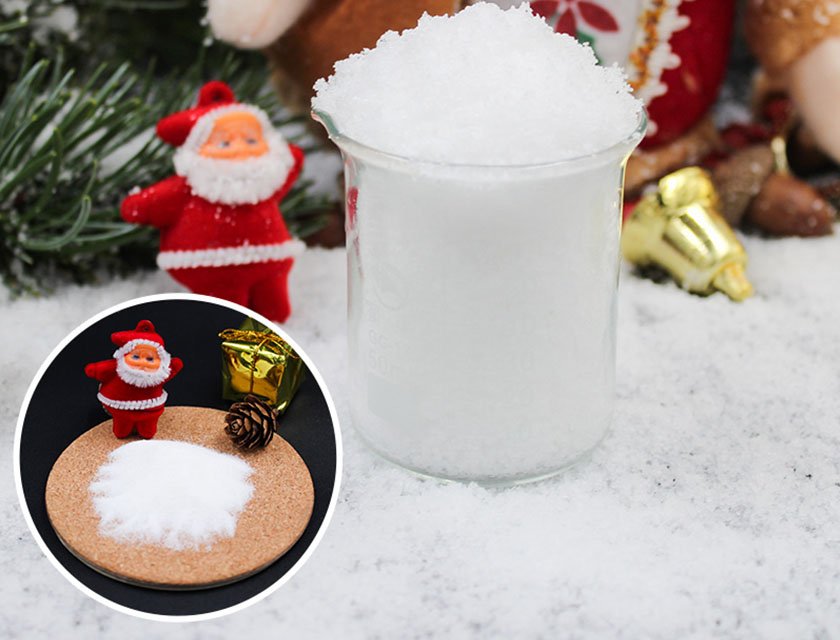Get Free Sample
Artificial snow is often used in ski resorts, film production, indoor ski halls and other scenarios. According to the production process and purpose, artificial snow can be divided into the following types:

Formed by high-pressure water and compressed air spray. This kind of artificial snow requires lower air temperature and appropriate humidity and is often used in ski resorts.
Preparation method: formed by high-pressure water and compressed air spray.
Environmental hazards:
To improve its "quality", chemicals or biological additives can be added to the water.
The artificial snow used in the 2010 Vancouver Winter Olympics was added with pesticides to make the water freeze at high temperatures.[1]
Snow "hardeners" such as salt and fertilizers can also be used to improve the quality of cross-country skiing tracks.
It is estimated that 49 million gallons of water were used to make artificial snow for the 2022 Winter Olympics.
Even if the use of artificial snow is driven by renewable energy, it still requires a lot of energy, which is both expensive and a huge consumption of water resources.
By rapidly cooling water at low temperatures and spraying it into tiny ice crystal particles. This type of snow is closer to the texture of natural snow and is often used in indoor ski resorts and filming.
Preparation method: Cool water quickly at low temperatures and spray it into tiny ice crystal particles.
Environmental hazards:
High energy consumption: A low temperature environment needs to be maintained, especially in indoor ski resorts and filming, where air conditioning and refrigeration equipment consume a lot of energy.
Water resource consumption: A large amount of water resources are also required, and the water usage efficiency may be low due to the refrigeration process.
Wastewater discharge: Melted water may contain refrigerant residues, which may pollute the water body.
Made using a foaming agent, fine foam is formed by spraying to simulate the effect of snow. Mainly used for temporary decoration and filming.
Preparation method: Made using a foaming agent, fine foam is formed by spraying to simulate the effect of snow.
Environmental hazards:
Chemical pollution: The foaming agent may contain chemicals that are harmful to the environment, which may be released into the air and soil during the spraying process.
Waste disposal: Foam is not easy to decompose naturally and requires special treatment. If improperly handled, it will pollute the environment.
Water pollution: Foam residues may enter the water body and have a negative impact on aquatic life and water quality.
The above three types of artificial snow manufacturing methods are all energy-intensive, consuming non-renewable resources on the earth and causing harm to the environment, which is a stumbling block to sustainable development. Next, we will introduce an environmentally friendly fake snow. The material is degradable and can absorb 300 times its own weight in water. It can effectively lock in water and reduce the waste of water resources, contributing to sustainable development.

SOCO® super absorbant polymer fake snow is an advanced synthetic snow technology made by using specific environmentally friendly materials and innovative manufacturing processes. This fake snow mainly uses super slurper polymer, which can absorb a large amount of water, expand rapidly and form particles similar to natural snow. The specific manufacturing process includes the following steps:
Material preparation: Select high-quality environmentally friendly polymer materials, which are usually based on acrylates or other compounds with good biocompatibility.
Water absorption: Expose the polymer material to an appropriate amount of water so that it quickly absorbs water and expands to form fine "snow" particles.
Forming treatment: In a container, the expanded polymer particles are processed into a form with the texture and appearance of real snow.
Quality control: Strict quality inspections are carried out to ensure that the particle size, shape and water absorption capacity of the fake snow meet the predetermined standards.
SOCO® polymer sodium polyacrylate artificial snow has a wide range of application scenarios, mainly including:
Film and television shooting: In movies, TV series, advertisements and other film and television works, SOCO® fake snow can create realistic winter scenes and enhance visual effects.
Indoor and outdoor decoration: used for decoration in shopping malls, exhibitions, theme parks and festivals to create a romantic snowy atmosphere.
Activities and performances: SOCO® polymers that absorb water fake snow can increase entertainment and viewing in various activities and performances, bringing a unique experience to the audience.
Ski resorts and training grounds: used in ski resorts and ski training grounds to provide a more realistic snow experience, especially in areas with unsuitable climatic conditions.
Environmentally friendly materials: use degradable or recyclable polymer materials to reduce long-term pollution to the environment.
Low-energy production: The manufacturing process is relatively energy-saving, does not require a large amount of compressed air or refrigeration equipment, and reduces energy consumption.
Efficient use of water resources: polymers have strong water absorption capacity, low water consumption and can be reused many times, reducing the consumption of water resources.
Non-toxic and harmless: The polymer materials used are non-toxic and harmless to the human body and the environment, and meet environmental protection and safety standards.
Recyclable and reusable: SOCO® high absorbent material fake snow after use can be recycled and reused through simple treatment to reduce the generation of waste.
In the field of decoration, SOCO® sap polymer fake snow also shines. Whether it's a holiday celebration, a shopping mall exhibition or a theme park, SOCO® sap polymer fake snow quickly creates a strong winter atmosphere, attracts customers' attention and enhances the attractiveness of the event or venue. Its non-toxic, non-hazardous and easy-to-clean properties make the decorating process safer and more environmentally friendly, while also reducing the burden of maintenance.
SOCO® sap polymer Fake Snow is one of a sodium polyacrylate suppliers of innovative environmentally friendly synthetic snow products. By using highly absorbent polymers and efficient manufacturing processes, snow effects can be achieved at a lower cost. Its wide range of application scenarios and significant environmental friendliness make it an ideal choice for film and television shooting, decoration and other fields. By using SOCO® Fake Snow, while ensuring visual effects and ease of use, negative impacts on the environment can be effectively reduced, promoting sustainable development.
Artificial snow is primarily made of water, but it undergoes a special process to simulate the appearance and behavior of natural snow. Sodium polyacrylate snow, often referred to as artificial snow or snow-making polymer, is a synthetic material used to create snow-like effects for various applications such as ski resorts, film productions, and event decorations.
Artificial snow is essential for many winter sports resorts and tourism economies, supporting jobs and economic activity. Artificial snow is a synthetic material designed to simulate natural snow. It is typically created by forcing water through a fine nozzle under high pressure or by freezing water droplets in a controlled environment.
Artificial snow is primarily made of water that has been processed through a machine to simulate natural snowfall. Fake snow for television, also known as artificial snow, is a specialized material designed to simulate the appearance and behavior of real snow on camera.
[1]https://www.globalclimatemedia.com/winter-olympics-2022-the-environmental-impact-of-fake-snow-how-its-made-and-why-it-poses-a-risk-to-athletes/
We have “Ask The Expert” online service 24/7. If you have any questions please contact us.